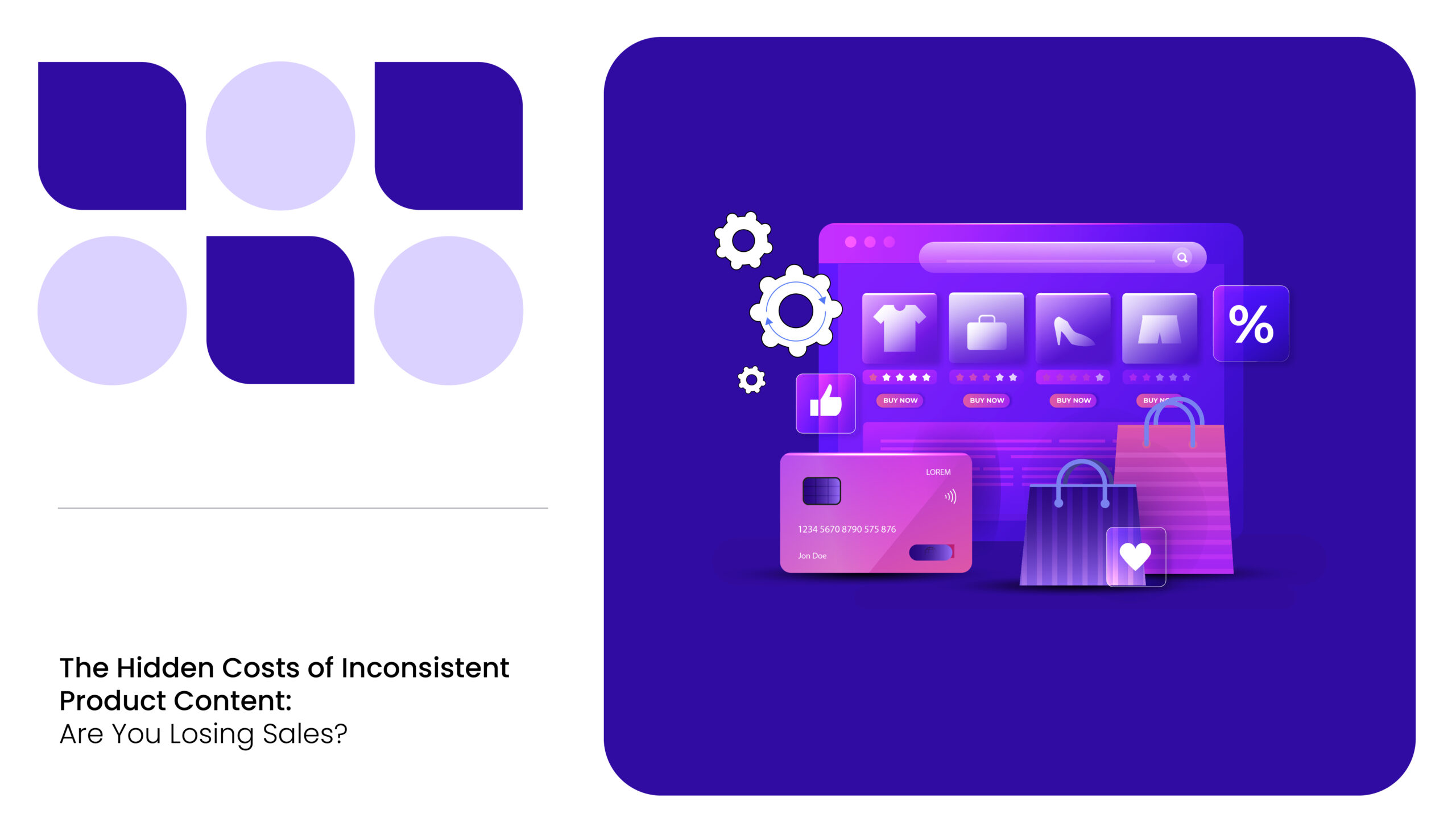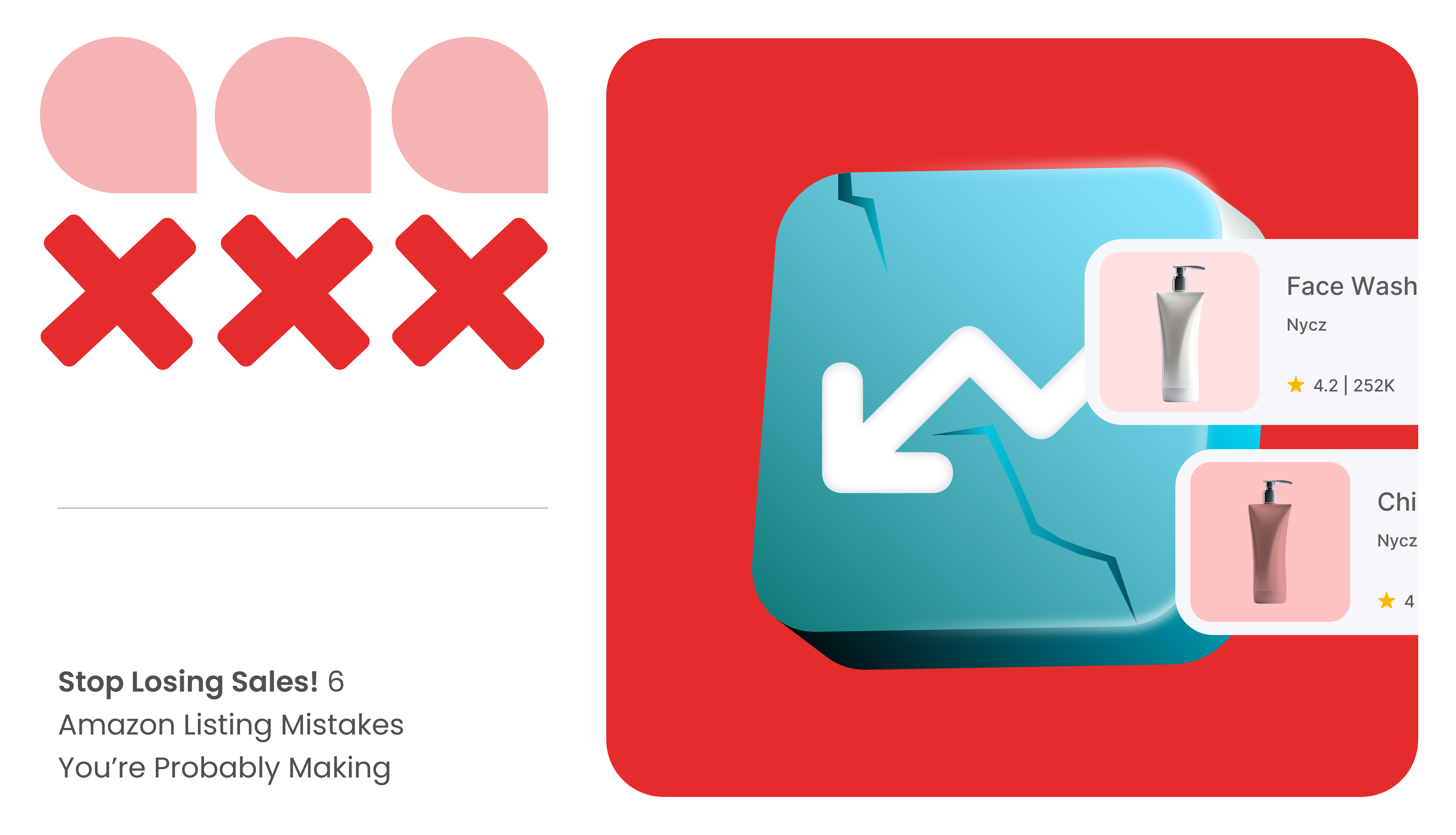Have you ever found yourself confused by conflicting product descriptions or unclear images while shopping online? Chances are, within seconds, you jumped to another listing with clearer information. That’s what we are diving into: the impact of inconsistent product content!
Did you know that 87% of shopper decisions are influenced by the accuracy of product content?
Consumers have an infinite scroll of choices, and they instinctively choose clarity and certainty. So, naturally, inaccuracies in product content, no matter how minor, cause shoppers to bounce, ultimately eroding brand trust, plummeting sales, and completely derailing the customer experience.
Let’s dig deeper into the hidden costs and impact of inconsistent product content.
How Does Inconsistent Product Content Impact Brand Growth?
The ripple effect of product data inaccuracy touches almost every part of your e-commerce strategy, from your brand image to your logistics.
1. Brand Image Takes A Hit
Research confirms 75% of surveyed global shoppers form negative opinions about a brand when they can’t find sufficient product information.
Once customers begin questioning the integrity of your product content, that skepticism extends beyond one product to your entire catalog. They’ll begin to wonder if any of your products can be trusted.
Worse, the damage isn’t easily reversible. Brand perception takes time to rebuild, and inconsistent product content erodes consumer confidence and catalyzes customer churn.
Once your brand’s reputation is tarnished, customers will be less likely to engage with you, and word-of-mouth and reviews will only amplify the damage.
2. Lost Sales and Lower Conversion Rates
The direct consequence of inconsistent product content on sales is lost revenue. Almost 53% of US shoppers abandon their carts when met with conflicting, missing, or confusing details.
Each time a customer leaves your site frustrated, that’s money lost, often permanently. Friction in the buying process (whether it’s confusion over specs, product images, or descriptions) directly correlates to a decrease in your conversion rate.
And even if your conversion rate is still decent, it’s not as high as it could be. Every small inconsistency might seem negligible, but cumulatively, it prevents you from hitting the sales potential you’re capable of.
Without timely content audits and product content optimization, your bad PDP drains your sales pipeline by creating repeated barriers to conversion.
3. Damage to Omnichannel Strategy
When your product content is inconsistent across various platforms, you are essentially splintering the customer experience. Omnichannel strategies depend on seamless, unified content across all touchpoints.
If customers see a product on your website and then encounter different information about the same product on Amazon or another marketplace, the friction disrupts their experience.
What happens next? A broken omnichannel experience leads to a fractured customer journey. Instead of feeling like they’re engaging with the same brand, consumers start to see your brand as disjointed and unreliable.

In Episode 8 of the Digital Shelf Insider podcast, Chris Perry, CLO, firstmovr shared his insights on shopper-centricity, product content optimization, and breaking silos for brand growth online. Tune into the full episode:
4. Operational Costs Go Up
A report states that 60% of shoppers have returned a product due to misleading product descriptions. The more discrepancies in your content, the more time and resources it takes to address them.
Each return isn’t just a lost sale. It’s also a logistical cost. The time spent processing returns, restocking inventory, manual product content optimization, and dealing with angry customers takes away from your core business operations.
These non-revenue-generating tasks can pile up quickly, creating a vicious cycle that diverts resources from business-building activities.
5. Negative Impact on Rankings and Visibility
It’s not just frustrating for customers; it confuses the algorithms as well.
Search engines and marketplaces like Amazon rely on accurate, rich product content to rank listings. If your product details are inconsistent or incomplete, you risk dropping in the rankings. With poor visibility, your products won’t show up in relevant searches, resulting in a significant decline in traffic.
It then creates a domino effect, harming everything from brand discoverability to customer retention.
READ MORE| Amazon listing mistakes can kill your brand growth! Check out Stop Losing Sales! 6 Amazon Listing Mistakes You’re Probably Making to learn more.
6. Increased Risk of Customer Returns and Negative Reviews
Shoppers don’t like surprises when the package arrives. Thanks to misleading product content, they will return it and likely leave a negative review in the process.
The costs of returns due to inconsistent content go beyond just the refunded sale. First, you’ve lost the potential revenue, but now you’ve also gained negative feedback that affects your online reputation.
Negative reviews are particularly damaging in e-commerce, where 84% of shoppers trust online reviews as much as personal recommendations.
This means a bad review due to mismatched product content isn’t just a one-off; it can tarnish your entire product line and make customers hesitate before buying any of your products in the future.

PDP Red Flags and Tips for Improving Product Data Accuracy
Here are the most certain telltale signs that your product data needs an audit, along with bonus tips for improving product data accuracy:

1. Conflicting Product Information Across Channels
Think about this: a customer browses your product on your website and sees a product description that reads, “This laptop has 16GB RAM.” They then go over to Amazon, where the same product has “8GB RAM” listed in the specs. Huge problem.
Inconsistent data like this directly undermines customer confidence. Even subtle discrepancies, like listing the product color as “silver” on your site and “gray” on Walmart, will make customers second-guess their purchase.
Tip: Use a content compliance tool that syncs data across all platforms in real-time to ensure consistency in product descriptions, specifications, and features across your website, Amazon, Walmart, and other retail channels.
2. Mismatched Images or Visual Assets
Let’s say you sell a high-end gaming chair. The image on your website shows a sleek, modern black chair, but the description on Amazon describes it in “dark charcoal grey.” When a consumer clicks on your website, they may assume they’re getting one product and receive something different altogether.
If the images and product descriptions don’t match, it leads to doubt, and doubt is the enemy of conversion. Even small mismatches, like showing a white button-up shirt in your product photos but only describing a blue one, will quickly turn into abandoned carts.
Tip: In case of SKU variations, ensure that each ASIN has a respective image variant (in terms of color, size, or quantity). Your content and visual assets (which include images, enhanced product content, and even 360-degree view and AR) should be in sync, aiming to replicate an in-store experience at best.
3. Missing or Incomplete Descriptions
Product descriptions are your selling points, your opportunity to tell the customer why they should choose your product. A weak or incomplete description is a missed sale.
If you’re selling a tech gadget, and the description reads, “High-performance gadget with Bluetooth.” That’s it. Customers need specifics. How long does the battery last? Is it waterproof? Does it support iOS and Android?
If you leave these details out while writing product descriptions, don’t be surprised when customers bounce to a competitor who provides all the necessary information.
Tip: Develop a standardized product description template that includes all essential details like size, material/ingredients, technical specifications, and unique selling points. Ensure this template is applied consistently across all platforms to avoid missing key information.
4. Misleading or Exaggerated Product Specifications
Customers depend on specs. Whether it’s the storage capacity of a smartphone or the dimensions of a sofa, getting specs wrong is a fast-track ticket to returns for “wrong” products.
Imagine advertising a product as “12 hours of battery life” and the customer finds it only lasts 8 hours in real-world usage. What’s going to happen next? A flood of returns and negative reviews. Worse yet, return rates are a killer for your profitability, especially in high-AOV categories like electronics.
And, your listing can be subject to eventual rejection on the retail platform due to non-compliance.
Tip: Always verify real-world performance metrics through internal testing or customer feedback before publishing specifications. Be honest about features like battery life or dimensions to avoid returns and dissatisfaction. Use disclaimers when necessary to manage customer expectations. Your content must inform, not exaggerate.
READ MORE| Amazon’s Rufus is a shopper favorite for quick product queries. Check out Optimizing Product Listings for Amazon Rufus AI: Best Practices for Brands.
Let’s Wrap Up
By now, you surely have a better idea of how product descriptions build trust (or maybe break it).
Fixing product content inconsistencies isn’t just about avoiding mistakes; it’s about building a more trustworthy, seamless, and compelling experience for your customers.
The brands that focus on maintaining accurate, high-quality product content set themselves up for stronger customer relationships, better conversion rates, and improved operational efficiency. So, the question isn’t whether you can afford to optimize your content; it’s whether you can afford not to.
With MetricsCart’s content compliance software, you can ensure your product content meets industry standards and retailer requirements with ease.
From content scorecards to evaluate titles, descriptions, images, and other specs to real-time alerts and automated audits, MetricsCart helps you maintain accurate, high-quality content that builds customer trust, boosts conversion rates, and drives continuous improvement.
Don’t let content setbacks hold you back; start optimizing today!
Struggling With Your Brand Messaging? Try Our Advanced Content Compliance Solutions!
FAQs
Inconsistent product content can significantly harm your SEO rankings. Search engines like Google prioritize accurate, high-quality, and consistent content across web pages. When product descriptions, titles, or images are inconsistent or incomplete, it confuses search engine algorithms, leading to lower rankings and reduced visibility. This ultimately makes it harder for customers to find your products, limiting your brand’s reach.
Yes, the impact of inconsistent product content can affect sales. When customers encounter conflicting or incomplete information, they are more likely to abandon their carts or choose a competitor with clearer, more trustworthy product details. Accurate, comprehensive, and consistent content builds confidence, leading to higher conversion rates and increased sales.
It’s recommended to audit your product content at least quarterly, but more frequent reviews, especially after product launches or platform updates, are ideal. Regular audits help you spot inconsistencies early, ensuring that all product details are aligned with your brand standards and retailer requirements, preventing any potential issues from impacting your sales or customer experience.
Inconsistent product content can lead to poor customer experiences, which often result in negative reviews. If the product received doesn’t match the description or image, customers feel misled, and they are more likely to leave unfavorable feedback. Over time, this can damage your brand’s reputation and deter potential buyers from making a purchase
Inconsistent branding across sales channels, whether it’s product descriptions, images, or messaging, creates confusion and weakens your brand identity. When customers encounter differing information on your website, Amazon, or social media, it reduces trust and makes your brand seem unreliable. Consistency across all platforms is key to building a cohesive brand image and a seamless customer experience.







